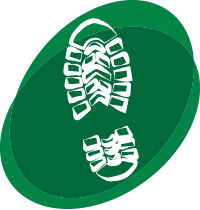Shoe prints are commonly found at the scene of a crime and can sometimes help link a suspect to the scene. Because prints tend to be partially observed or smudgy, comparing crime scene prints with reference images from a putative shoe can be challenging. Footwear examiners rely on guidelines such as those published by SWGTREAD [1] to visually assess the similarity between two or more footwear impressions, one reason being that reliable, quantitative methods have yet to be validated for use in real cases. To help in the development of such methods, we created a study dataset of images of outsole impressions that shared class characteristics and degree of wear and that were subject to a specific type of degradation. We also propose a method to quantify the similarity between two outsole images that extends the capabilities of MC-COMP [2]. The proposed method is composed of three steps; (1) extracting image descriptors, (2) aligning images using the maximum clique, (3) calculating similarity values using two different classifiers; (a) degree of overlap between the two images, and (b) a score produced by a random forest. To explore the performance of the algorithm we propose, we compared degraded, crime scene-like images to high-quality reference images produced by the same or by different shoes. Even though comparisons involved matches or very close non-matches, and one of the images was blurry, the algorithm shows good source classification performance.
The effect of image descriptors on the performance of classifiers of footwear outsole image pairs

Journal: Forensic Science International
Published: 2022
Primary Author: Soyoung Park
Secondary Authors: Alicia Carriquiry
Type: Publication
Research Area: Footwear
Related Resources
Shoeprint Alignment and Comparison using Maximum Cliques
This presentation is from the 107th International Association for Identification (IAI) Annual Educational Conference, National Harbor, Maryland, August 20-26, 2023. Posted with permission of CSAFE.
An algorithm for source identification of footwear impressions—its application on pristine shoeprints and crime-scene like shoeprints
This presentation is from the 107th International Association for Identification (IAI) Annual Educational Conference, National Harbor, Maryland, August 20-26, 2023. Posted with permission of CSAFE.
CSAFE Project Update & ASCLD FRC Collaboration
This presentation highlighted CSAFE’s collaboration with the ASCLD FRC Collaboration Hub.
Source identification of shoeprints in mock crime scene using an algorithm based on automatic alignment
This presentation is from the 75th Anniversary Conference of the American Academy of Forensic Sciences, Orlando, Florida, February 13-18, 2023. Posted with permission of CSAFE


